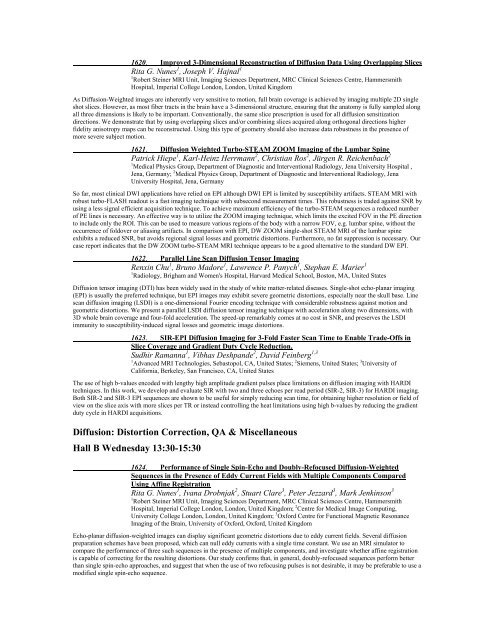Traditional Posters: Diffusion & Perfusion - ismrm
Traditional Posters: Diffusion & Perfusion - ismrm
Traditional Posters: Diffusion & Perfusion - ismrm
Create successful ePaper yourself
Turn your PDF publications into a flip-book with our unique Google optimized e-Paper software.
1620. Improved 3-Dimensional Reconstruction of <strong>Diffusion</strong> Data Using Overlapping Slices<br />
Rita G. Nunes 1 , Joseph V. Hajnal 1<br />
1 Robert Steiner MRI Unit, Imaging Sciences Department, MRC Clinical Sciences Centre, Hammersmith<br />
Hospital, Imperial College London, London, United Kingdom<br />
As <strong>Diffusion</strong>-Weighted images are inherently very sensitive to motion, full brain coverage is achieved by imaging multiple 2D single<br />
shot slices. However, as most fiber tracts in the brain have a 3-dimensional structure, ensuring that the anatomy is fully sampled along<br />
all three dimensions is likely to be important. Conventionally, the same slice prescription is used for all diffusion sensitization<br />
directions. We demonstrate that by using overlapping slices and/or combining slices acquired along orthogonal directions higher<br />
fidelity anisotropy maps can be reconstructed. Using this type of geometry should also increase data robustness in the presence of<br />
more severe subject motion.<br />
1621. <strong>Diffusion</strong> Weighted Turbo-STEAM ZOOM Imaging of the Lumbar Spine<br />
Patrick Hiepe 1 , Karl-Heinz Herrmann 2 , Christian Ros 2 , Jürgen R. Reichenbach 2<br />
1 Medical Physics Group, Department of Diagnostic and Interventional Radiology, Jena University Hospital ,<br />
Jena, Germany; 2 Medical Physics Group, Department of Diagnostic and Interventional Radiology, Jena<br />
University Hospital, Jena, Germany<br />
So far, most clinical DWI applications have relied on EPI although DWI EPI is limited by susceptibility artifacts. STEAM MRI with<br />
robust turbo-FLASH readout is a fast imaging technique with subsecond measurement times. This robustness is traded against SNR by<br />
using a less signal efficient acquisition technique. To achieve maximum efficiency of the turbo-STEAM sequences a reduced number<br />
of PE lines is necessary. An effective way is to utilize the ZOOM imaging technique, which limits the excited FOV in the PE direction<br />
to include only the ROI. This can be used to measure various regions of the body with a narrow FOV, e.g. lumbar spine, without the<br />
occurrence of foldover or aliasing artifacts. In comparison with EPI, DW ZOOM single-shot STEAM MRI of the lumbar spine<br />
exhibits a reduced SNR, but avoids regional signal losses and geometric distortions. Furthermore, no fat suppression is necessary. Our<br />
case report indicates that the DW ZOOM turbo-STEAM MRI technique appears to be a good alternative to the standard DW EPI.<br />
1622. Parallel Line Scan <strong>Diffusion</strong> Tensor Imaging<br />
Renxin Chu 1 , Bruno Madore 1 , Lawrence P. Panych 1 , Stephan E. Marier 1<br />
1 Radiology, Brigham and Women's Hospital, Harvard Medical School, Boston, MA, United States<br />
<strong>Diffusion</strong> tensor imaging (DTI) has been widely used in the study of white matter-related diseases. Single-shot echo-planar imaging<br />
(EPI) is usually the preferred technique, but EPI images may exhibit severe geometric distortions, especially near the skull base. Line<br />
scan diffusion imaging (LSDI) is a one-dimensional Fourier encoding technique with considerable robustness against motion and<br />
geometric distortions. We present a parallel LSDI diffusion tensor imaging technique with acceleration along two dimensions, with<br />
3D whole brain coverage and four-fold acceleration. The speed-up remarkably comes at no cost in SNR, and preserves the LSDI<br />
immunity to susceptibility-induced signal losses and geometric image distortions.<br />
1623. SIR-EPI <strong>Diffusion</strong> Imaging for 3-Fold Faster Scan Time to Enable Trade-Offs in<br />
Slice Coverage and Gradient Duty Cycle Reduction.<br />
Sudhir Ramanna 1 , Vibhas Deshpande 2 , David Feinberg 1,3<br />
1 Advanced MRI Technologies, Sebastopol, CA, United States; 2 Siemens, United States; 3 University of<br />
California, Berkeley, San Francisco, CA, United States<br />
The use of high b-values encoded with lengthy high amplitude gradient pulses place limitations on diffusion imaging with HARDI<br />
techniques. In this work, we develop and evaluate SIR with two and three echoes per read period (SIR-2, SIR-3) for HARDI imaging.<br />
Both SIR-2 and SIR-3 EPI sequences are shown to be useful for simply reducing scan time, for obtaining higher resolution or field of<br />
view on the slice axis with more slices per TR or instead controlling the heat limitations using high b-values by reducing the gradient<br />
duty cycle in HARDI acquisitions.<br />
<strong>Diffusion</strong>: Distortion Correction, QA & Miscellaneous<br />
Hall B Wednesday 13:30-15:30<br />
1624. Performance of Single Spin-Echo and Doubly-Refocused <strong>Diffusion</strong>-Weighted<br />
Sequences in the Presence of Eddy Current Fields with Multiple Components Compared<br />
Using Affine Registration<br />
Rita G. Nunes 1 , Ivana Drobnjak 2 , Stuart Clare 3 , Peter Jezzard 3 , Mark Jenkinson 3<br />
1 Robert Steiner MRI Unit, Imaging Sciences Department, MRC Clinical Sciences Centre, Hammersmith<br />
Hospital, Imperial College London, London, United Kingdom; 2 Centre for Medical Image Computing,<br />
University College London, London, United Kingdom; 3 Oxford Centre for Functional Magnetic Resonance<br />
Imaging of the Brain, University of Oxford, Oxford, United Kingdom<br />
Echo-planar diffusion-weighted images can display significant geometric distortions due to eddy current fields. Several diffusion<br />
preparation schemes have been proposed, which can null eddy currents with a single time constant. We use an MRI simulator to<br />
compare the performance of three such sequences in the presence of multiple components, and investigate whether affine registration<br />
is capable of correcting for the resulting distortions. Our study confirms that, in general, doubly-refocused sequences perform better<br />
than single spin-echo approaches, and suggest that when the use of two refocusing pulses is not desirable, it may be preferable to use a<br />
modified single spin-echo sequence.















